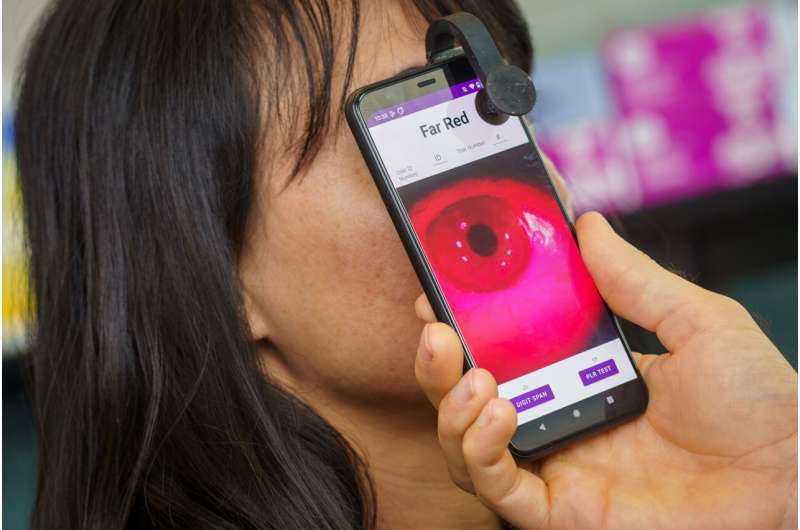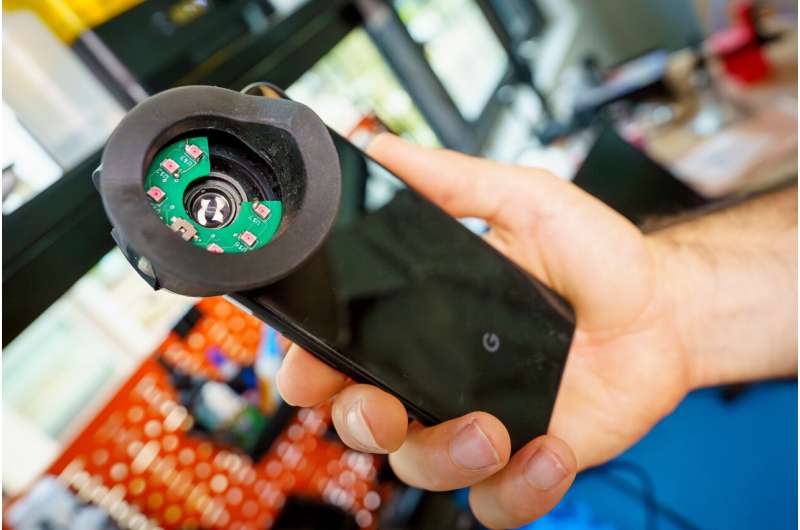This article has been reviewed according to Science X's editorial process and policies. Editors have highlighted the following attributes while ensuring the content's credibility:
fact-checked
peer-reviewed publication
trusted source
proofread
Smartphone attachment could increase racial fairness in neurological screening

Engineers at the University of California San Diego have developed a smartphone attachment that could enable people to screen for a variety of neurological conditions, such as Alzheimer's disease and traumatic brain injury, at low cost—and do so accurately regardless of their skin tone.
The technology, published in Scientific Reports, has the potential to improve the equity and accessibility of neurological screening procedures while making them widely available on all smartphone models.
The attachment fits over a smartphone's camera and improves its ability to capture clear video recordings and measurements of the pupil, which is the dark center of the eye. Recent research has shown that tracking pupil size changes during certain tasks can provide valuable insight into an individual's neurological functions. For example, the pupil tends to dilate during complex cognitive tasks or in response to unexpected stimuli.
However, tracking pupil size can be difficult in individuals with dark eye colors, such as those with darker skin tones, because conventional color cameras struggle to distinguish the pupil from the surrounding dark iris.
To enhance the visibility of the pupil, UC San Diego engineers equipped their smartphone attachment with a specialized filter that selectively permits a certain range of light into the camera. That range is called far-red light—the extreme red end of the visible spectrum located just before infrared light. Melanin, the dark pigment in the iris, absorbs most visible wavelengths of light but reflects longer wavelengths, including far-red light. By imaging the eye with far-red light while blocking out other wavelengths, the iris appears significantly lighter, making it easier to see the pupil with a regular camera.
"There has been a large issue with medical device design that depends on optical measurements ultimately working only for those with light skin and eye colors, while failing to perform well for those with dark skin and eyes," said study senior author Edward Wang, an electrical and computer engineering professor in The Design Lab at UC San Diego, where he is the director of the Digital Health Technologies Lab.
"By focusing on how we can make this work for all people while keeping the solution simple and low cost, we aim to pave the way to a future of fair access to remote, affordable health care."

Another feature of this technology that makes it more accessible is that it is designed to work on all smartphones. Traditionally, pupil measurements have been performed using infrared cameras, which are only available in high-end smartphone models. Since regular cameras cannot detect infrared light, this traditional approach limits accessibility to those who can afford more expensive smartphones. By using far-red light, which is still part of the visible spectrum and can be captured by regular smartphone cameras, this technology levels the playing field.
"The issue with relying on specialized sensors like an infrared camera is that not all phones have it," said study first author Colin Barry, an electrical and computer engineering Ph.D. student in Wang's lab. "We created an inexpensive and fair solution to provide these kinds of emerging neurological screenings regardless of the smartphone price, make or model."
To use the attachment, a person clips it over a smartphone's camera and places it over their eye. Then, the smartphone administers a pupil response test by providing a flash of bright light and recording video of the eye during the test. A machine learning model uses the recorded video of the eye to track pupil size.
The researchers tested their smartphone attachment on a diverse group of 12 volunteers with a wide range of eye colors, from light blue to dark brown. The smartphone measurements were validated against a pupillometer, the gold standard device used in the clinic for measuring pupil size.
The next phase of this project involves taking steps towards deploying the technology for large-scale neurological screenings in at-home environments. To reach that stage, the researchers are working on optimizing the design for mass manufacturing. They are also making the technology more user friendly, especially for older adults given their elevated risk for developing neurological conditions.
More information: Colin Barry et al, Racially fair pupillometry measurements for RGB smartphone cameras using the far red spectrum, Scientific Reports (2023). DOI: 10.1038/s41598-023-40796-0




















